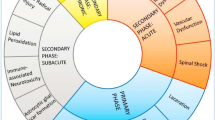Summary
Nerve section is followed by a reduction of motor and sensory conduction velocity in the proximal segment of the injured nerve. This reduction of velocity is associated with retrograde changes in fiber size. If reinnervation does not occur within the next 1 1/2–2 years, retrograde degeneration of nerve fibers results, and the amplitude of the evoked nerve potential in the proximal segment of the injured nerve decreases. This retrograde degeneration is probably significant in view of the poor results frequently obtained after nerve transplantation which is carried out too late.
Zusammenfassung
Traumatische Nervenläsionen sind regelmäßig von einer Herabsetzung der maximalen motorischen und sensiblen Nervenleitgeschwindigkeit im supraläsionellen Abschnitt gefolgt. Dieser korrespondieren retrograde Faserveränderungen mit Reduktion des Axondurchmessers, wobei wahrscheinlich die dicken, rasch leitenden Fasern bevorzugt betroffen sind. Das Ausbleiben einer Reinnervation innerhalb von 1 1/2–2 Jahren führt vermutlich zur retrograden Faser-Degeneration, da nach dieser Zeit eine starke Erniedrigung des evozierten Nervenpotentials im proximalen Nervenabschnitt resultiert. Diese retrograde Degeneration dürfte für die oft schlechten Ergebnisse nach spät erfolgender Nerventransplantation von Bedeutung sein.
Similar content being viewed by others
References
Acheson, G. H., Lee, E. S., Morison, R. S.: A deficiency in the phrenic respiratory discharges parallel to retrograde degeneration. J. Neurophysiol. 5, 269–273 (1942)
Aitken, J. T., Thomas, P. K.: Retrograde changes in fibre size following nerve section. J. Anat. 96, 121–129 (1962)
Clemens, R.: Eine einfache Methode zur Quantifizierung des Schweregrades peripherer Nervenschädigungen. Akt. Neurol. 1, 46–50 (1974)
Cragg, B. G., Thomas, P. K.: Changes in conduction velocity and fibre size proximal to peripheral nerve lesions. J. Physiol. 157, 315–327 (1961)
Ebeling, P., Gilliat, R. W., Thomas, P. K.: A clinical and electrical study of ulnar nerve lesions in the hand. J. Neurol. Neurosurg. Psychiat. 23, 1–9 (1960)
Eccles, J. C., Krnjević, K., Miledi, R.: Delayed effects of peripheral severance of afferent nerve fibers on the efficacy of their central synapses. J. Physiol. 145, 204–220 (1959)
Estable, C., Acosta-Ferreira, W., Soleto, J. R.: An electron microscope study of the regenerating nerve fibers. Z. Zellforschg. 46, 387–399 (1957)
Gutmann, E., Holubář, J.: Atrophy of nerve fibres in the central stump following nerve section and the possibilities of its prevention. Arch. Int. Stud. Neurol. 1, 1–11 (1951)
Kiraly, J. K., Krnjević, K.: Some retrograde changes in function of nerves after peripheral section. Quart. J. exp. Physiol. 64, 244–257 (1959)
Krücke, W.: Pathologie der peripheren Nerven. In: Handbuch der Neurochirurgie. Hrsg. von H. Olivecrona, W. Tönnies, W. Krenkel. Berlin-Heidelberg-New York: Springer 1974
Lampert, P. W.: A comparative electron microscopic study of reactive, degenerating, regenerating and dystrophic axons. J. Neuropath. exp. Neurol. 26, 345–368 (1967)
Lubinska, L.: Region of transition between preserved and regenerating parts of myelinated nerve fibers. J. comp. Neurol. 113, 315–335 (1959)
Moberg, E.: Objective methods for determining the functional value of sensibility in the hand. J. Bone Jt. Surg. 40 B, 454–459 (1958)
Schlote, W.: Die läsionsbedingten primär-retrograden Veränderungen der Axone zentraler Nervenfasern im elektronenmikroskopischen Bild. Acta neuropath. 4, 138–157 (1964)
Schröder, J. M.: Altered ratio between the axon diameter and myelin sheath thickness in regenerated nerve fibers. Brain Res. 45, 49–65 (1972)
Smorto, M. P., Basmajian, J. V.: Clinical Electroneurography. Baltimore: Williams and Wilkins 1972
Stöhr, M.: Neurogener Jitter und intermittierende Blockierungen bei posttraumatischer Reinnervation. Z. EEG-EMG. 6, 63–69 (1975)
Thomas, P. K.: Motor nerve conduction in the carpal tunnel syndrome. Neurology 10, 1045–1050 (1960)
Thomas, P. K., Lambert, E. H., Cseuz, K. A.: Electrodiagnostic aspects of the carpal tunnel syndrome. Arch. Neurol. 16, 635–641 (1967)
Weiss, P., Hiscoe, H. B.: Experiments on the mechanism of nerve growth. J. exp. Zool. 107, 315–396 (1948)
Author information
Authors and Affiliations
Rights and permissions
About this article
Cite this article
Stöhr, M., Schumm, F. & Reill, P. Retrograde changes in motor and sensory conduction velocity after nerve injury. J. Neurol. 214, 281–287 (1977). https://doi.org/10.1007/BF00316573
Received:
Issue Date:
DOI: https://doi.org/10.1007/BF00316573




